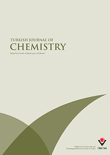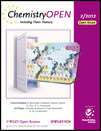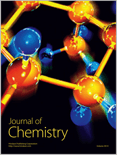
CHINESE JOURNAL OF CHEMISTRY
Scope & Guideline
Shaping the future of chemistry with impactful research.
Introduction
Aims and Scopes
- Synthetic Chemistry:
This includes the development of new synthetic methodologies, novel reactions, and the synthesis of complex organic compounds, particularly those with biological significance. - Catalysis:
The journal features significant contributions in the area of catalysis, including both homogeneous and heterogeneous catalysis, highlighting advancements in catalyst design, mechanism studies, and applications in industrial processes. - Materials Chemistry:
Research on the synthesis, characterization, and application of new materials, particularly nanomaterials, polymers, and hybrid materials, is a core focus, emphasizing their use in energy, electronics, and environmental applications. - Chemical Biology:
Papers exploring the intersection of chemistry and biology, including drug design, medicinal chemistry, and the development of biomolecular probes, are prominently featured, showcasing the journal's commitment to advancing health-related research. - Environmental Chemistry:
The journal also addresses environmental challenges through the publication of research on pollutant degradation, green chemistry practices, and the development of sustainable chemical processes. - Computational Chemistry:
The integration of computational methods in understanding chemical systems and predicting properties is a growing area of interest, reflecting the journal's emphasis on theoretical and computational studies. - Analytical Chemistry:
Research that focuses on the development of novel analytical techniques and their applications in various fields, including environmental monitoring and biological analysis, is regularly published.
Trending and Emerging
- Green Chemistry and Sustainability:
There is a growing trend towards research that emphasizes environmentally friendly practices, including the development of sustainable chemical processes and materials that minimize waste and energy consumption. - Nanotechnology and Nanomaterials:
The exploration of nanomaterials and their applications in various fields, including catalysis, drug delivery, and energy storage, is increasingly prominent, reflecting the broader interest in nanotechnology. - Photochemistry and Photocatalysis:
Research on the use of light to drive chemical reactions, particularly in the context of solar energy conversion and environmental remediation, has gained traction, highlighting the importance of sustainable energy solutions. - Bioinspired and Biomimetic Chemistry:
Studies that draw inspiration from biological systems to design new materials or processes are on the rise, showcasing the interdisciplinary nature of modern chemical research. - Machine Learning and Artificial Intelligence in Chemistry:
The integration of computational approaches, particularly machine learning and AI, in chemical research for predictive modeling and data analysis is emerging as a significant trend, enhancing the efficiency and scope of chemical investigations. - Electrochemistry and Energy Storage:
Research focused on electrochemical processes, including batteries and fuel cells, has become increasingly relevant, driven by the global demand for sustainable energy solutions.
Declining or Waning
- Traditional Organic Synthesis:
There has been a noticeable decrease in papers solely focused on traditional organic synthesis methods without the incorporation of novel strategies or applications, as the field moves towards more innovative and efficient approaches. - Inorganic Chemistry:
Research specifically dedicated to fundamental inorganic chemistry, including coordination complexes and organometallics, has become less prevalent, possibly due to the growing emphasis on materials chemistry and catalysis. - Fundamental Physical Chemistry:
Papers purely addressing theoretical aspects of physical chemistry, without substantial experimental validation or application, have diminished, as there is a stronger preference for interdisciplinary studies that apply physical chemistry principles to practical problems. - Natural Product Chemistry:
Research focusing explicitly on the isolation and characterization of natural products has waned, with a shift towards studies that integrate natural products into broader chemical and biological contexts.
Similar Journals

TURKISH JOURNAL OF CHEMISTRY
Inspiring Breakthroughs in Chemical ScienceTURKISH JOURNAL OF CHEMISTRY, published by the Tubitak Scientific & Technological Research Council Turkey, serves as a significant platform for the dissemination of research in the diverse field of chemistry. Since its inception in 1996, this peer-reviewed journal has made substantial contributions to the body of knowledge within the field, currently holding a respectable Q3 ranking in the category of Chemistry (miscellaneous) as of 2023. Researchers and professionals alike rely on this journal for its wide-ranging discussions, innovative methodologies, and noteworthy findings pertinent to both fundamental and applied chemistry. With an ISSN of 1300-0527 and a commitment to promoting scientific progress, the journal is accessible to a global audience and encourages the open sharing of insights that drive advancements in chemistry. The extended timeframe of convergence until 2024 highlights the journal's dedication to fostering ongoing research and collaboration within the scientific community. As a valuable resource for researchers, professionals, and students, the Turkish Journal of Chemistry aims to inspire new discoveries and facilitate knowledge transfer in a dynamic and evolving discipline.

ChemistryOpen
Advancing Chemistry for AllChemistryOpen is a leading open access journal published by WILEY-V C H VERLAG GMBH, dedicated to advancing the field of chemistry. With its ISSN 2191-1363, this journal has been a vital platform since its inception in 2012, promoting unrestricted access to innovative research findings and critical reviews in various chemistry domains. As a testament to its growing influence, ChemistryOpen has achieved a commendable Q2 quartile ranking in the 2023 Chemistry (miscellaneous) category, which highlights its quality and impact within the academic community. Researchers, professionals, and students benefit from the journal's commitment to making high-quality research accessible, facilitating knowledge transfer and collaborative insights among chemists worldwide. The journal's transparent open access model ensures that groundbreaking discoveries and methodologies are readily disseminated, fostering a culture of innovation and interdisciplinary dialogue in the ever-evolving landscape of chemistry.

Moroccan Journal of Chemistry
Advancing Chemistry Knowledge, One Article at a Time.Moroccan Journal of Chemistry, published by the University Mohammed Premier Oujda, serves as a pivotal platform for researchers and professionals in the field of chemistry, particularly focusing on diverse and emerging areas within the discipline. Established in 2018, this open-access journal facilitates widespread dissemination of scholarly articles, ensuring that cutting-edge research reaches a global audience. With an ISSN of 2351-812X and categorized in the Q3 quartile for miscellaneous chemistry in 2023, the journal maintains rigorous peer-review standards while fostering an inclusive environment for scientific dialogue. Located in Morocco, it aims to bridge local and international research communities, contributing to the advancement of knowledge in chemistry. As it continues to grow, the Moroccan Journal of Chemistry remains an essential resource for students, educators, and professionals eager to stay abreast of the latest developments in the field.

Nature Reviews Chemistry
Transforming Chemistry Through Critical AnalysisNature Reviews Chemistry is a premier journal published by NATURE PORTFOLIO, dedicated to advancing scholarly discourse in the broad field of chemistry. With an impressive impact factor and a ranking in the 99th percentile across its categories—ranked #2 in General Chemical Engineering and #4 in General Chemistry according to Scopus—this journal is recognized for its high-quality, peer-reviewed articles that synthesize and analyze the latest advancements in chemical research. Operating under a convergence framework from 2017 to 2024, Nature Reviews Chemistry aims to provide comprehensive insights and critical examinations of contemporary chemical practices, thereby reinforcing its status as a vital resource for researchers, professionals, and students alike. Although it is not an open-access journal, the breadth and authority of its content make it essential for those looking to stay at the forefront of chemical sciences.

EGYPTIAN JOURNAL OF CHEMISTRY
Empowering Researchers with Cutting-Edge Chemical KnowledgeThe Egyptian Journal of Chemistry, published by the National Information & Documentation Centre (NIDOC), serves as a vital platform for disseminating novel research and advancements in the field of chemistry and its interdisciplinary applications. Established in 2004 and continuing its publication through 2024, this journal encapsulates a diverse range of topics including Biochemistry, Chemical Engineering, and Materials Science, reflected in its respectable Scopus rankings. With an array of Quartile rankings indicating its varying impact across different categories, scholars can benefit from its insights into innovative solutions and methodologies that address pressing scientific challenges. Although it currently does not operate under an open access model, researchers and students are encouraged to leverage its findings as it plays a pivotal role in the academic landscape of Egypt and beyond. For those engaged in chemical research, the Egyptian Journal of Chemistry stands as an essential resource, contributing significantly to the global body of scientific knowledge.

CHEMICAL RESEARCH IN CHINESE UNIVERSITIES
Advancing Chemistry Through Collaborative ResearchCHEMICAL RESEARCH IN CHINESE UNIVERSITIES is a prominent academic journal dedicated to the dissemination of high-quality research in the field of chemistry and related educational methodologies. Published by HIGHER EDUCATION PRESS, this journal has established itself as a vital resource for researchers and professionals looking to stay at the forefront of chemical sciences. With an impressive impact factor and ranked in the Q2 quartile for both Chemistry and Education categories, it highlights significant advancements while maintaining rigorous peer-review standards. The journal's ISSN is 1005-9040 and its E-ISSN is 2210-3171, ensuring broad accessibility to its global readership. Although it does not offer open access, its contributions are vital to understanding the dynamics of chemistry research and education within and beyond China. With converged publication years from 1999 through to 2024, CHEMICAL RESEARCH IN CHINESE UNIVERSITIES continues to be an essential platform for innovative studies and critical discussions in the expanding realm of chemistry.

Journal of Chemistry
Innovating Chemistry for a Global AudienceJournal of Chemistry, published by Hindawi Ltd, serves as a critical platform for advancing knowledge in the field of chemistry, particularly in its miscellaneous sub-disciplines. With an impressive 2023 Scopus Rank of #123 out of 408 and positioned in the Q2 quartile, this journal exemplifies a robust academic rigor that appeals to researchers, professionals, and students alike. It features articles related to innovative chemical research and developments, catering to a diverse audience eager to contribute to the growing body of literature in the chemical sciences. The journal has been operational from 2013 to 2024, and its Open Access model ensures that findings are easily accessible to a global audience, fostering collaboration and knowledge sharing. With a commitment to quality and relevance, the Journal of Chemistry continues to play a significant role in shaping contemporary chemical research and education.

RUSSIAN JOURNAL OF GENERAL CHEMISTRY
Exploring New Horizons in General ChemistryThe Russian Journal of General Chemistry is a prominent scholarly publication dedicated to advancing the field of general chemistry. Published by MAIK NAUKA/INTERPERIODICA/SPRINGER, this journal contributes significantly to the global chemistry landscape, offering a platform for researchers and professionals to share their latest findings and methodologies. With an ISSN of 1070-3632 and an E-ISSN of 1608-3350, it has established itself as a resource for high-quality research articles since its inception in 1996. Though currently indexed in the Q4 category for chemistry (miscellaneous) and ranking #299 out of 408 in general chemistry according to Scopus, the journal remains an important venue for academic contributions that bridge gaps in traditional chemical disciplines. Desiring to cater to a diverse range of interests within chemistry, the journal actively encourages submissions that reflect significant scientific achievements, innovations, and collaborative studies. Although the journal does not currently offer open access, its role in disseminating crucial chemical research cannot be overstated. Researchers and students alike will find valuable insights and rigorous scientific discourse in its pages.

AUSTRALIAN JOURNAL OF CHEMISTRY
Fostering global collaboration in chemical sciences.The Australian Journal of Chemistry, with an ISSN of 0004-9425 and an E-ISSN of 1445-0038, is a distinguished publication from CSIRO PUBLISHING, dedicated to advancing the field of chemistry since its inception in 1948. Based in Australia, this journal serves as a platform for original research articles, reviews, and innovative studies that encompass a wide spectrum of chemical disciplines, aiming to foster communication and collaboration among researchers globally. Despite its Q3 ranking in the Chemistry (Miscellaneous) category and standing at rank #236 in Scopus’ general chemistry classification, it remains an essential resource for professionals and students seeking to stay informed about emerging trends and discoveries in chemistry. The journal does not offer open access, emphasizing the premium quality of peer-reviewed content that adheres to rigorous academic standards. By bridging theory and practice, the Australian Journal of Chemistry continues to play a crucial role in shaping the future of chemical sciences.

Chemija
Exploring the Frontiers of Chemical Science.Chemija is a prominent journal in the field of chemistry, published by LIETUVOS MOKSLU AKAD LEIDYKLA in Lithuania. With a focus on diverse topics within the realm of chemistry, this journal aims to disseminate original research articles, reviews, and discussions that advance the understanding and application of chemical science. Although it currently holds a Q4 ranking in the miscellaneous category of chemistry, Chemija is committed to elevating its impact through the publication of high-quality research, making significant contributions to the discipline. The journal operates under a non-open access model, ensuring that articles undergo rigorous peer review to uphold academic standards. Researchers, professionals, and students are encouraged to explore the wealth of knowledge within its pages as it endeavors to bridge gaps across various subfields of chemistry from 2008 to 2024. With a dedicated readership and a growing database of insightful publications, Chemija serves as an essential resource in the ever-evolving landscape of chemical research.